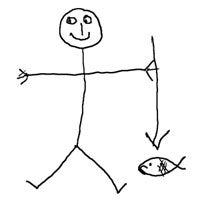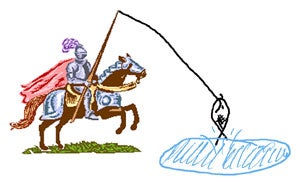| The other week, whilst up in the attic cleaning out the cage that we keep mad cousin Ronan Deanos in, I came across some interesting papers that I believe document the history of our beloved sport from its conception through to modern times and sheds some new light on how certain practices came about. It appears from cave drawings that early man was spear fishing for food in Prehistoric Britain.
But there also seems to have been some conflict between certain of these primitive anglers due to the fact that some had very expensive barbel spears that had been given to them, and others who could not obtain a free very expensive barbel spear and had resorted to selling all their furs and eating smaller pies to buy the said spear. Around the time of the second ice age several well known barbel swims froze over and vicious disputes broke out over fishing rights between different groups that have passed down through the genes to the present day. In 400 BC, with the upsurge in population on the continent, saw a migration of large numbers of Eastern Europeans to British Shores and with them came the practice of catching fish with a net, and within 50 years spear fishing in Britain became redundant. Modern day sport fishing began in the 100 Years War with France, the ordinary infantry man, when not fighting would spend his spare time with a hook and line tied to the end of his pike staff catching fish. At the time Latin was used in naming fish but that was to change when pike man Bob Nubb stated “I caught it using line on the end of my pike staff, so I’ll call it a pike.” Whether he threw it up the bank or not is not recorded. He then caught a smaller fish, claiming “It’s a lot ruddy smaller than the pike so I’ll call this a Rudd.” The knights of this time saw the infantry fishing and began using string on the end of their lances to catch the fish, but these gentry having better food than fish (ye olde wild boar) returned the fish to the water and so angling was born.
Some of these knights (for some quaint reason often dressed as circus clowns), began galloping around the country at the mention of big fish and so became the first specimen hunters. Many hybrid species were entered for British records but this was sorted out when DFA (Don’t F***ing Ask) was instigated. The monks at this time began selective breeding of carp to produce larger and heavier fish and soon realised that people would come to the monasteries and pay to fish for the day in the Abbots pond and so began the day ticket waters we have today. Several anglers got together to form the fishing guild in 1512 and one well known angler Matt Hanes formed GFT (Good Fishing Things) that made everything in the colours of the woodland so that anglers could hide from the monks to avoid the day ticket prices. This led to the bailiff, or Bazturd as he was known in those days, coming into being. A post that still exists today in some rural areas and continued in old tradition. The papers state that for some anglers fishing was just an excuse to escape from their wives for a while and even suggest that some of those on the Crusades used it as time away to sleep in a tent, drink, womanise and did very little fishing. And so modern day carp fishing was born. Angling continued in this form until 1887 when Rodney Blowhorn, tired of the fish he sought being out of reach of his pole, invented the reel. Rodney realised that this meant he did not need a long pole and so the phrase Rod and Reel was coined. Over time several anglers used their skills to win fame and fortune and these are documented in the paper, a few examples are given: John, Will’s son, was court jester to Henry VIII and combined fishing skills with an ability to laugh inanely at anything. Henry used John’s accurate casting skills to send love letters to Anne Boleyn. Jan Pourterpotty is said to have been so skilled in realistic camouflage that he became one of Robin Hood’s merry men and stole the Sherriff of Nottingham’s fish and was never once caught by Sir Bazturd the Third, the Sherriff’s bailiff. This is but a short r When you purchase through links on our site, we may earn an affiliate commission, which supports our community.
|
Welcome!Log into your account














